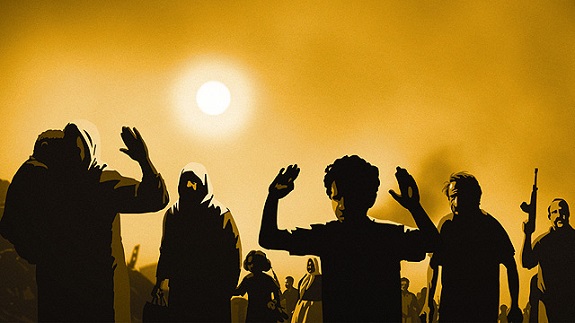This post is part of the 2nd Annual One of My All-Time Favorite Cartoons Blogathon, hosted by Steve at MovieMovieBlogBlog. Read the rest of the posts in this event HERE!
Waltz with Bashir, the 2008 Israeli animated documentary written and directed by Ari Folman, certainly would never be called a “cartoon.” But it is an exceptional example of the mostly untapped potential of animation’s use beyond children’s films.

The film explores the elusive quality of memory when it comes to living through traumatic events like war. Folman visits a friend who tells him of a recurring dream he has about his experiences as an Israeli soldier during the 1982 Lebanon War. Folman realizes he has almost no memories of his own experiences during the war. Advised by a friend to interview other former comrades to help him remember, he begins a journey that forces him to recall one of the most tragic and horrific events of the war: a massacre of Palestinian refugees by Christian Phalangists.
As he pieces together what happened to him and his friends during the war, the film rips apart many assumptions. For instance, it almost immediately destroys the myth of the Israeli Defense Forces as some kind of tightly run war machine. Sent over the border to Lebanon in tanks, the young soldiers relentlessly and aimlessly shoot automatic weapons for no reason other than abject terror. They shoot up a car and kill a family—again, for no reason other than fear.

It also reveals coping mechanisms used by soldiers who are in the midst of chaos and uncertainty. One says he watch horrific events as if through a camera. Another tells of intentionally inducing himself into having illusions.
Folman realizes his only clear memories are of his furloughs, when he spent most of his time upset about how his girlfriend dumped him. On his way to what he thinks may be his own death, he concentrates on how he will get revenge on his girlfriend by dying in battle, highlighting the maturity level of the soldiers sent to fight in war.

As he continues to interview friends and former comrades, he eventually recalls that he was in the second or third ring of Israeli soldiers that surrounded the Sabra and Shatila camps where the massacre took place. Now understanding bits of memory where he and his comrades shot flairs into the sky, he realizes they lit them to help the Phalangists see as they “cleaned out the camps” of terrorists. Slowly, it becomes obvious to him that even though Israeli soldiers witnessed men, women, and children being massacred and reported it to their superiors, nothing was done to stop it until long after it began. He concludes his amnesia stemmed from guilt that he and his comrades were complicit in the massacre.

Entering the camps the next day, the Israeli soldiers see the bodies of the murdered Palestinians piled up in alleys and streets. At this point, the film ends with the animation dissolving into actual footage of the death and destruction.
It’s impossible to imagine the impact of this film would be the same if it had been a live action feature. Animation is a perfect medium to explore how human beings can use memory both protect ourselves from events too horrible to bear and force ourselves to face what we need to face. The movie often plays like a dreamscape, at times to the point of surrealism.

Animator Yoni Goodman invented the film’s style of animation by combining Adobe Flash cutouts, classic animation and 3D techniques. Art Director David Polonsky created about 75 per cent of the illustrations used in the film. (The film was later adapted into a graphic novel.)
This film is enhanced with the use of classical and 1980s pop music, as well as some songs written for the movie that comment on what is happening on screen. The title “Waltz with Bashir” refers to one of the interviewees Frenkel recalling how he took an automatic rifle and “waltzed” through a Beirut street covered with posters of murdered Lebanese president Bashir Gemayel. It is set to a waltz by Chopin.

It’s hardly surprising that the film, while acclaimed all over the world, remains to this day controversial. It is banned in parts of the Arab world, including Lebanon. There have been (I think justified) accusations that the Palestinians are props in a story that focuses mostly on the pain of the Israeli soldiers. But at the same time, it tells a tale of how evil flourishes while those who can stop it look away or, willfully or not, erase it from memory. Animation paired with harrowing real-life images help to bring that point home in a most brutal way.


Beautiful blog entry. The late Roger Ebert once said something to the effect that the otherworldly quality of animation captures actions and thoughts the way that live-action film cannot. This movie obviously proves it. Thanks so much for contributing to the blogathon!
Thank you, Steve. It was tough to write about this after this week’s events, but I admire this film so much. Thanks for hosting! (And next year I’m picking something funny to write about.) 🙂
Animation is a medium with many different uses for the creative mind. Waltz With Bashir’s take on the story it tells a harrowing and difficult tale. One story cannot be all stories and I always find that criticism worthless because all stories are worthwhile.
I agree and would like to see animation used in many more ways that it is currently.